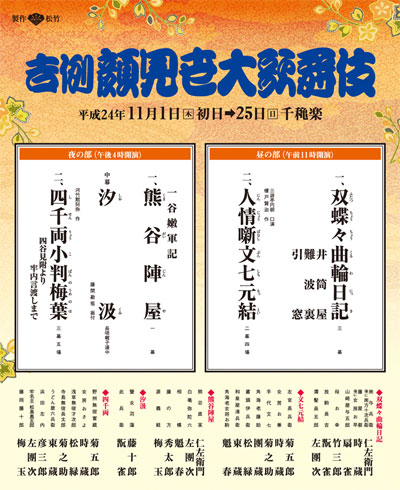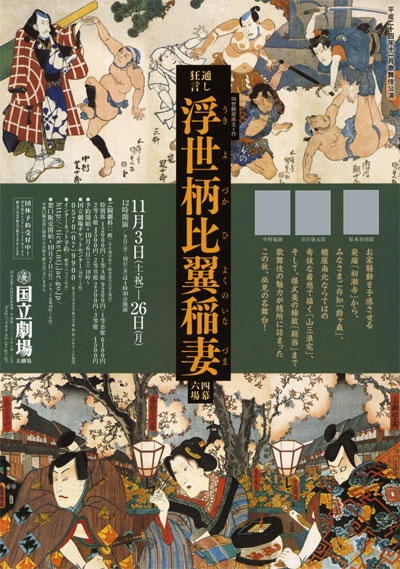| NOVEMBER 2012 |
|
5 shows in T˘ky˘ (Shinbashi Enbuj˘, National Theatre, Meijiza) 1 in Toyooka (Eirakukan), 1 in Naruto (ďtsuka Museum of Art), 1 on Shikoku Island (Kanamaruza) and 2 tours (Sh˘chiku ďkabuki Tour, Kinshű Special Tour)!
|
| Shinbashi Enbuj˘ (T˘ky˘) |
| Dates | 1 ~ 25 November 2012 (Kichirei Kaomise ďkabuki) Annual Festive Face-Showing Grand Kabuki |
| MatinÚe |
|
| Evening | |
| Casting |
Kataoka Nizaemon, Onoe Kikugor˘, Nakamura Tokiz˘, Nakamura Baigyoku, Nakamura Kanjaku, Nakamura Senjaku, Onoe Kikunosuke, Nakamura Kaishun, Kataoka Hidetar˘, Ichikawa Sadanji, Ichikawa Danz˘, Band˘ Hikosabur˘, Nakamura T˘z˘, Band˘ Takesabur˘, Onoe Sh˘roku, Kawarasaki Gonjűr˘, Band˘ Shűch˘, Ichimura Kakitsu, Sawamura Yoshijir˘, ďtani Keiz˘, Nakamura Matsue, Band˘ Kamesabur˘, Band˘ Kametoshi, Onoe Matsuya, Onoe Ukon, Nakamura Baishi, Nakamura Mantar˘, Fujima Taiga |
| Comments |
|
 |
| Meijiza (T˘ky˘) |  |
| Dates | 3 ~ 27 November 2012 (Jűichigatsu Hanagata Kabuki) November Young Actors Kabuki |
| MatinÚe |
Keisei Hangonk˘
|
| Evening | |
| Casting |
Ichikawa Ennosuke, Ichikawa Monnosuke, Ichikawa Danshir˘, Ichikawa Ukon, Ichikawa Emiya, Ichikawa Shun'en, Ichikawa En'ya, Ichikawa Juen, Nakamura Kikaku, Ichikawa Omez˘, Ichimura Manjir˘, Nakamura Yonekichi |
| Comments |
The Omodakaya guild is back at the Meijiza!
|
| National Theatre (T˘ky˘) |
| Dates | 3 ~ 26 November 2012 |
| Program |
|
| Casting |
Matsumoto K˘shir˘, Nakamura Fukusuke, Nakamura Kinnosuke, Ichikawa Komaz˘, Kataoka Ichiz˘, Band˘ Yajűr˘, ďtani Tomoemon, Ichikawa Unosuke, Nakamura Utae, Matsumoto Kingo, Sawamura S˘nosuke, ďtani Hirotar˘, ďtani Hiromatsu, Band˘ Shingo, Nakamura Hayato |
| Comments |
Revival at the National Theatre of 6 scenes from one of Tsuruya Nanboku IV's longest and most famous dramas:
|
 |
| Kanamaruza (Konpira) |
| Dates | 1 ~ 11 November 2012 Band˘ Tamasabur˘ Special Performances |
| Program |
Yuki Kane no Misaki Ibuki |
| Casting | |
| Comments |
Band˘ Tamasabur˘ will star in two Buy˘ dances, "Yuki" and "Kane no Misaki". The 3rd item in the program is a special creation, which features both the Kabuki star and the professional taiko drumming troupe Kod˘. The creation is based on their seventh albums, which is entitled "Ibuki". |
| Sh˘chiku ďkabuki Tour | |
| Dates | 1 ~ 25 November 2012 (Sh˘chiku ďkabuki) Sh˘chiku Grand Kabuki |
| Program | |
| Casting |
Nakamura Hashinosuke, Kataoka Takatar˘, Kataoka Kamez˘, Nakamura Kotar˘ |
| Comments |
A special Autumn tour sponsored by the Sh˘chiku!
|
| Eirakukan (Toyooka) |  |
| Dates | 4 ~ 9 November 2012 (Eirakukan ďkabuki) Eirakukan Grand Kabuki |
| Program |
Jitsuroku Chűshingura Waki Noboru Mizu-ni Koi Taki (Koi Tsukami) |
| Casting |
Kataoka Ainosuke, Kamimura Kichiya, Band˘ Shinsha, Nakamura Kazutar˘, Nakamura Tanenosuke, Kamimura Kichitar˘ |
| Comments |
This is the 5th Kabuki program at the Eirakukan, a renovated traditional theater built in the city of Toyooka (prefecture of Hy˘go). |
| ďtsuka Museum of Art (Naruto) |
| Dates | 13 ~ 15 November 2012 (Sistine Kabuki) |
| Program |
Shuten D˘ji |
| Casting |
Kataoka Ainosuke, Kamimura Kichiya, Band˘ Shinsha, Nakamura Kazutar˘, Nakamura Tanenosuke, Kamimura Kichitar˘ |
| Comments |
4th edition of the Sistine Kabuki, a Kabuki program within the Sistine Hall of the ďtsuka Museum of Art, which is located in the city of Naruto (Tokushima prefecture). Inside this museum, there are more than 1,000 replicas of priceless masterpieces of Western art, from ancient murals to modern paintings, which are reproduced in ceramic to their original size. The Sistine Hall is of course a "reproduction" of the Vatican Sistine Chapel. The drama, a newly-created Kabuki drama, is based on the legend of Shuten D˘ji. |
| Kinshű Special Tour | |
| Dates | 10 ~ 22 November 2012 |
| Program |
Geidan Aki no Irokusa Oharame Kuniiri Yakko |
| Casting |
Nakamura Kankur˘, Nakamura Shichinosuke, Nakamura Nakashir˘, Nakamura Nakanosuke, Nakamura Ich˘, Sawamura Kunihisa |
| Comments |
The word kinshű means "Autumn Brocade". This Autumn tour stars the two young stars Nakamura Kankur˘ and Nakamura Shichinosuke. The second item in the program is a speech about the 2012 shűmei of Nakamura Kankur˘. All others items in this tour program are dances.
|
|
|
| Contact | Main | Top | Updates | Actors | Plays | Playwrights | Programs | Links | FAQ | Glossary | Chronology | Illustrations | Prints | Characters | Derivatives | Theaters | Coming soon | News |